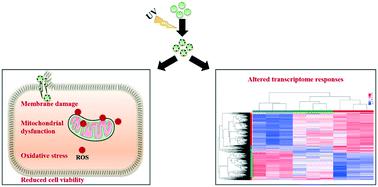当前位置:
X-MOL 学术
›
Environ. Sci.: Nano
›
论文详情
Our official English website, www.x-mol.net, welcomes your
feedback! (Note: you will need to create a separate account there.)
Ultraviolet-induced photodegradation elevated the toxicity of polystyrene nanoplastics on human lung epithelial A549 cells
Environmental Science: Nano ( IF 5.8 ) Pub Date : 2021-07-22 , DOI: 10.1039/d1en00465d Qingying Shi 1 , Jingchun Tang 1 , Xiaomei Liu 1 , Rutao Liu 2
Environmental Science: Nano ( IF 5.8 ) Pub Date : 2021-07-22 , DOI: 10.1039/d1en00465d Qingying Shi 1 , Jingchun Tang 1 , Xiaomei Liu 1 , Rutao Liu 2
Affiliation

|
The widespread presence of nanoplastics (NPs), with small particle sizes and high specific surface area, leads to the exposure and potential health risk for humans. The plastic particles widely detected in the indoor and outdoor air imply potential threats to the human respiratory system. However, the impact of aging NPs on their toxicity has been poorly considered, although it is an inevitable process suffered by them once they enter the environment. In this study, the aging of polystyrene (PS) NPs by photodegradation under ultraviolet irradiation for 2 months was investigated, and the toxicities of pristine and aged NPs to human lung epithelial A549 cells were compared. The results revealed alterations in the physicochemical properties with the size of NPs reduced and the abundant oxygen-containing groups formed on the surface. The toxic effects of the pristine and aged NPs at the cellular level on the cell viability, oxidative stress, membrane damage and mitochondrial dysfunction were illustrated in A549 cells, indicating that the aged NPs exhibited greater cytotoxicity than pristine NPs and this toxicity was in a positively aging time-related manner. Transcriptome analysis further revealed the impacts of aged NPs on A549 cells at the molecular level, wherein the aged NPs presented aggravated interference in gene expression, reconfirming the elevated toxicity of NPs after ultraviolet-induced photodegradation. This study highlights the importance of photodegradation on the toxicity of NPs in human health, which is of great significance for the risk assessment of NPs.
中文翻译:

紫外线诱导的光降解提高了聚苯乙烯纳米塑料对人肺上皮 A549 细胞的毒性
纳米塑料 (NPs) 的广泛存在,具有小粒径和高比表面积,导致人类接触和潜在健康风险。在室内和室外空气中广泛检测到的塑料颗粒意味着对人体呼吸系统的潜在威胁。然而,老化的 NPs 对其毒性的影响一直没有得到很好的考虑,尽管这是它们一旦进入环境所遭受的不可避免的过程。在这项研究中,研究了聚苯乙烯 (PS) NPs 在紫外线照射下光降解 2 个月的老化,并比较了原始和老化 NPs 对人肺上皮 A549 细胞的毒性。结果表明,随着纳米颗粒尺寸的减小和表面形成丰富的含氧基团,理化性质发生了变化。在 A549 细胞中说明了原始和老化 NPs 在细胞水平上对细胞活力、氧化应激、膜损伤和线粒体功能障碍的毒性作用,表明老化 NPs 比原始 NPs 表现出更大的细胞毒性,并且这种毒性呈正相关。老化时间相关的方式。转录组分析进一步揭示了老化纳米颗粒在分子水平上对 A549 细胞的影响,其中老化纳米颗粒对基因表达的干扰加剧,再次证实了紫外线诱导光降解后纳米颗粒的毒性升高。本研究强调了光降解对纳米颗粒对人体健康毒性的重要性,对纳米颗粒的风险评估具有重要意义。在 A549 细胞中说明了膜损伤和线粒体功能障碍,表明老化的 NPs 表现出比原始 NPs 更大的细胞毒性,并且这种毒性与老化时间呈正相关。转录组分析进一步揭示了老化纳米颗粒在分子水平上对 A549 细胞的影响,其中老化纳米颗粒对基因表达的干扰加剧,再次证实了紫外线诱导光降解后纳米颗粒的毒性升高。本研究强调了光降解对纳米颗粒对人体健康毒性的重要性,对纳米颗粒的风险评估具有重要意义。在 A549 细胞中说明了膜损伤和线粒体功能障碍,表明老化的 NPs 表现出比原始 NPs 更大的细胞毒性,并且这种毒性与老化时间呈正相关。转录组分析进一步揭示了老化纳米颗粒在分子水平上对 A549 细胞的影响,其中老化纳米颗粒对基因表达的干扰加剧,再次证实了紫外线诱导光降解后纳米颗粒的毒性升高。本研究强调了光降解对纳米颗粒对人体健康毒性的重要性,对纳米颗粒的风险评估具有重要意义。转录组分析进一步揭示了老化纳米颗粒在分子水平上对 A549 细胞的影响,其中老化纳米颗粒对基因表达的干扰加剧,再次证实了紫外线诱导光降解后纳米颗粒的毒性升高。本研究强调了光降解对纳米颗粒对人体健康毒性的重要性,对纳米颗粒的风险评估具有重要意义。转录组分析进一步揭示了老化纳米颗粒在分子水平上对 A549 细胞的影响,其中老化纳米颗粒对基因表达的干扰加剧,再次证实了紫外线诱导光降解后纳米颗粒的毒性升高。本研究强调了光降解对纳米颗粒对人体健康毒性的重要性,对纳米颗粒的风险评估具有重要意义。
更新日期:2021-08-13
中文翻译:

紫外线诱导的光降解提高了聚苯乙烯纳米塑料对人肺上皮 A549 细胞的毒性
纳米塑料 (NPs) 的广泛存在,具有小粒径和高比表面积,导致人类接触和潜在健康风险。在室内和室外空气中广泛检测到的塑料颗粒意味着对人体呼吸系统的潜在威胁。然而,老化的 NPs 对其毒性的影响一直没有得到很好的考虑,尽管这是它们一旦进入环境所遭受的不可避免的过程。在这项研究中,研究了聚苯乙烯 (PS) NPs 在紫外线照射下光降解 2 个月的老化,并比较了原始和老化 NPs 对人肺上皮 A549 细胞的毒性。结果表明,随着纳米颗粒尺寸的减小和表面形成丰富的含氧基团,理化性质发生了变化。在 A549 细胞中说明了原始和老化 NPs 在细胞水平上对细胞活力、氧化应激、膜损伤和线粒体功能障碍的毒性作用,表明老化 NPs 比原始 NPs 表现出更大的细胞毒性,并且这种毒性呈正相关。老化时间相关的方式。转录组分析进一步揭示了老化纳米颗粒在分子水平上对 A549 细胞的影响,其中老化纳米颗粒对基因表达的干扰加剧,再次证实了紫外线诱导光降解后纳米颗粒的毒性升高。本研究强调了光降解对纳米颗粒对人体健康毒性的重要性,对纳米颗粒的风险评估具有重要意义。在 A549 细胞中说明了膜损伤和线粒体功能障碍,表明老化的 NPs 表现出比原始 NPs 更大的细胞毒性,并且这种毒性与老化时间呈正相关。转录组分析进一步揭示了老化纳米颗粒在分子水平上对 A549 细胞的影响,其中老化纳米颗粒对基因表达的干扰加剧,再次证实了紫外线诱导光降解后纳米颗粒的毒性升高。本研究强调了光降解对纳米颗粒对人体健康毒性的重要性,对纳米颗粒的风险评估具有重要意义。在 A549 细胞中说明了膜损伤和线粒体功能障碍,表明老化的 NPs 表现出比原始 NPs 更大的细胞毒性,并且这种毒性与老化时间呈正相关。转录组分析进一步揭示了老化纳米颗粒在分子水平上对 A549 细胞的影响,其中老化纳米颗粒对基因表达的干扰加剧,再次证实了紫外线诱导光降解后纳米颗粒的毒性升高。本研究强调了光降解对纳米颗粒对人体健康毒性的重要性,对纳米颗粒的风险评估具有重要意义。转录组分析进一步揭示了老化纳米颗粒在分子水平上对 A549 细胞的影响,其中老化纳米颗粒对基因表达的干扰加剧,再次证实了紫外线诱导光降解后纳米颗粒的毒性升高。本研究强调了光降解对纳米颗粒对人体健康毒性的重要性,对纳米颗粒的风险评估具有重要意义。转录组分析进一步揭示了老化纳米颗粒在分子水平上对 A549 细胞的影响,其中老化纳米颗粒对基因表达的干扰加剧,再次证实了紫外线诱导光降解后纳米颗粒的毒性升高。本研究强调了光降解对纳米颗粒对人体健康毒性的重要性,对纳米颗粒的风险评估具有重要意义。









































 京公网安备 11010802027423号
京公网安备 11010802027423号